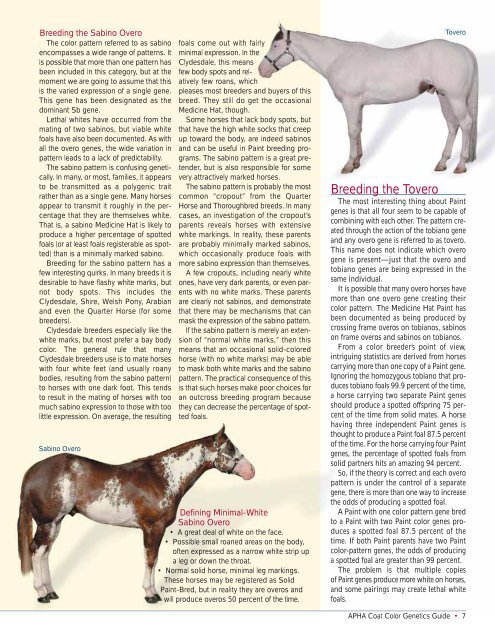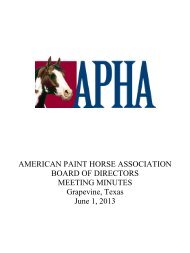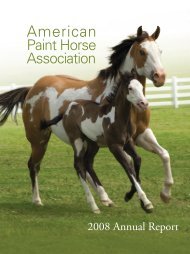Coat Color Genetics - Press - American Paint Horse Association
Coat Color Genetics - Press - American Paint Horse Association
Coat Color Genetics - Press - American Paint Horse Association
You also want an ePaper? Increase the reach of your titles
YUMPU automatically turns print PDFs into web optimized ePapers that Google loves.
Breeding the Sabino Overo<br />
The color pattern referred to as sabino<br />
encompasses a wide range of patterns. It<br />
is possible that more than one pattern has<br />
been included in this category, but at the<br />
moment we are going to assume that this<br />
is the varied expression of a single gene.<br />
This gene has been designated as the<br />
dominant Sb gene.<br />
Lethal whites have occurred from the<br />
mating of two sabinos, but viable white<br />
foals have also been documented. As with<br />
all the overo genes, the wide variation in<br />
pattern leads to a lack of predictability.<br />
The sabino pattern is confusing genetically.<br />
In many, or most, families, it appears<br />
to be transmitted as a polygenic trait<br />
rather than as a single gene. Many horses<br />
appear to transmit it roughly in the percentage<br />
that they are themselves white.<br />
That is, a sabino Medicine Hat is likely to<br />
produce a higher percentage of spotted<br />
foals (or at least foals registerable as spotted)<br />
than is a minimally marked sabino.<br />
Breeding for the sabino pattern has a<br />
few interesting quirks. In many breeds it is<br />
desirable to have flashy white marks, but<br />
not body spots. This includes the<br />
Clydesdale, Shire, Welsh Pony, Arabian<br />
and even the Quarter <strong>Horse</strong> (for some<br />
breeders).<br />
Clydesdale breeders especially like the<br />
white marks, but most prefer a bay body<br />
color. The general rule that many<br />
Clydesdale breeders use is to mate horses<br />
with four white feet (and usually roany<br />
bodies, resulting from the sabino pattern)<br />
to horses with one dark foot. This tends<br />
to result in the mating of horses with too<br />
much sabino expression to those with too<br />
little expression. On average, the resulting<br />
Sabino Overo<br />
foals come out with fairly<br />
minimal expression. In the<br />
Clydesdale, this means<br />
few body spots and relatively<br />
few roans, which<br />
pleases most breeders and buyers of this<br />
breed. They still do get the occasional<br />
Medicine Hat, though.<br />
Some horses that lack body spots, but<br />
that have the high white socks that creep<br />
up toward the body, are indeed sabinos<br />
and can be useful in <strong>Paint</strong> breeding programs.<br />
The sabino pattern is a great pretender,<br />
but is also responsible for some<br />
very attractively marked horses.<br />
The sabino pattern is probably the most<br />
common “cropout” from the Quarter<br />
<strong>Horse</strong> and Thoroughbred breeds. In many<br />
cases, an investigation of the cropout’s<br />
parents reveals horses with extensive<br />
white markings. In reality, these parents<br />
are probably minimally marked sabinos,<br />
which occasionally produce foals with<br />
more sabino expression than themselves.<br />
A few cropouts, including nearly white<br />
ones, have very dark parents, or even parents<br />
with no white marks. These parents<br />
are clearly not sabinos, and demonstrate<br />
that there may be mechanisms that can<br />
mask the expression of the sabino pattern.<br />
If the sabino pattern is merely an extension<br />
of “normal white marks,” then this<br />
means that an occasional solid-colored<br />
horse (with no white marks) may be able<br />
to mask both white marks and the sabino<br />
pattern. The practical consequence of this<br />
is that such horses make poor choices for<br />
an outcross breeding program because<br />
they can decrease the percentage of spotted<br />
foals.<br />
Defining Minimal-White<br />
Sabino Overo<br />
• A great deal of white on the face.<br />
• Possible small roaned areas on the body,<br />
often expressed as a narrow white strip up<br />
a leg or down the throat.<br />
• Normal solid horse, minimal leg markings.<br />
These horses may be registered as Solid<br />
<strong>Paint</strong>-Bred, but in reality they are overos and<br />
will produce overos 50 percent of the time.<br />
Tovero<br />
Breeding the Tovero<br />
The most interesting thing about <strong>Paint</strong><br />
genes is that all four seem to be capable of<br />
combining with each other. The pattern created<br />
through the action of the tobiano gene<br />
and any overo gene is referred to as tovero.<br />
This name does not indicate which overo<br />
gene is present—just that the overo and<br />
tobiano genes are being expressed in the<br />
same individual.<br />
It is possible that many overo horses have<br />
more than one overo gene creating their<br />
color pattern. The Medicine Hat <strong>Paint</strong> has<br />
been documented as being produced by<br />
crossing frame overos on tobianos, sabinos<br />
on frame overos and sabinos on tobianos.<br />
From a color breeder’s point of view,<br />
intriguing statistics are derived from horses<br />
carrying more than one copy of a <strong>Paint</strong> gene.<br />
Ignoring the homozygous tobiano that produces<br />
tobiano foals 99.9 percent of the time,<br />
a horse carrying two separate <strong>Paint</strong> genes<br />
should produce a spotted offspring 75 percent<br />
of the time from solid mates. A horse<br />
having three independent <strong>Paint</strong> genes is<br />
thought to produce a <strong>Paint</strong> foal 87.5 percent<br />
of the time. For the horse carrying four <strong>Paint</strong><br />
genes, the percentage of spotted foals from<br />
solid partners hits an amazing 94 percent.<br />
So, if the theory is correct and each overo<br />
pattern is under the control of a separate<br />
gene, there is more than one way to increase<br />
the odds of producing a spotted foal.<br />
A <strong>Paint</strong> with one color pattern gene bred<br />
to a <strong>Paint</strong> with two <strong>Paint</strong> color genes produces<br />
a spotted foal 87.5 percent of the<br />
time. If both <strong>Paint</strong> parents have two <strong>Paint</strong><br />
color-pattern genes, the odds of producing<br />
a spotted foal are greater than 99 percent.<br />
The problem is that multiple copies<br />
of <strong>Paint</strong> genes produce more white on horses,<br />
and some pairings may create lethal white<br />
foals.<br />
APHA <strong>Coat</strong> <strong>Color</strong> <strong>Genetics</strong> Guide • 7




